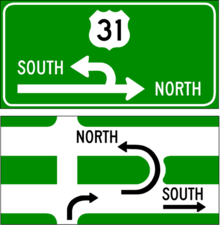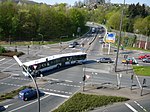Michigan Left

Michigan Left, also called Median U-Turn (MUT), is an unconventional intersection that is particularly common in the US state of Michigan . The peculiarity of this type of intersection is that vehicles are not allowed to turn directly left. Instead, they must turn right and do a U-turn . A separate turning lane is available for this purpose about 400 m after the intersection .
A prerequisite for the construction of such an intersection is a road with separate lanes to leave enough space for the turning lane. The intersection itself is usually regulated with a traffic light.
The design of the intersection in this way should bring two advantages: On the one hand, the traffic throughput should be increased due to the reduced number of traffic light phases, and on the other hand, the increased risk of accidents when turning left is avoided. The traffic light phase saved, including its amber phases and protection time, extends the release time of the main direction.
Texas U-turn
The Texas U-Turn is a slang term for a connecting ramp for turning like the Michigan Left , which is located between the Dutch ramps immediately before the feeder to a junction . It directs the turning traffic past the intersections of the feeder. When using a DDI or DCD , the Texas U-Turn is obsolete or another lane is required. These turning lanes are most common in Texas . On the existing Frontage Roads there is also the traffic that comes from the secondary directions that have no bridge over the motorway.
Super street
The Superstreet, also called "J-Turn", is a light signal-free and for the secondary direction not directly passable intersection, comparable opposite secondary directions of the Michigan Left , and was researched in more detail by the traffic engineer Richard Kramer from Alabama in the early 1980s. In addition to the "RCUT" ("Restricted Crossing U-Turn intersection", see next section), a variant designated as Superstreet for the main direction of free flowing traffic is listed, which includes 2 turning lanes, around all 4 left-turns of the main and secondary directions and through traffic the secondary directions to use. These must be far enough away from the improper intersection to allow cross-traffic to change lanes. Superstreet and Michigan Left move left turns backwards, while an intersection with continuous traffic moves left turns up to take them out of the conflict.
Restricted Crossing U-Turn Intersection
A Restricted Crossing U-Turn Intersection (RCUT) is a variant in which the secondary direction is also not directly connected, but left-turners in the main directions turn tangentially directly into the secondary directions. The knot has two conflicting directions. One example is on the West Big Beaver Road Troy (Michigan) at the level of Lakeview Drive at 42 ° 33 '41.1 " N , 83 ° 10' 52.7" W .
- Built RCUTs
In the US states of Louisiana, New York, North Carolina, Maryland, Missouri, and Utah:
- US Route 17 south of Leland, North Carolina to the state line in South Carolina.
- US Route 15 in Frederick County, Maryland , north of Maryland State Route 26
- After the construction of these RCUTs in 2009, the number of accidents with injuries fell by 40%, with fatalities by 70%, and the number of accidents with property damage by 20%.
Michigan Urban Diamond Interchange
Michigan Urban Diamond Interchange (MUDI), also called Median U-Turn Interchange (MUT), is the Michigan Left in a junction with Dutch ramps , which therefore requires three bridge structures and is therefore more efficient on the feeder. One example is on the interstate 696, the Walter P Reuther Freeway in Southfield at 42 ° 29 '14.5 " N , 83 ° 14' 28.3" W . In the Italian Foligno are at Strada Statale Flaminia three-armed MUDI at 42 ° 57 '6.3 " N , 12 ° 43' 20.4" O .
Application in Germany
A three-armed ampel controlled node with a 70 meters rearwardly displaced left turn Gern is in Mannheim on the Ludwigshafen road ( Federal Highway 36 ) at the level of Hermsheimer road at 49 ° 27 '49 " N , 8 ° 30' 23" O to find.
In Cologne there is a Michigan Left at the intersection of Vorgebirgstraße and Ulrichgasse to Sachsenring, 50 ° 55 ′ 26 ″ N , 6 ° 57 ′ 9 ″ E
Similar traffic hubs can be found on Rheinstraße in Wiesbaden.
The confluence of Archivstraße on Lavesallee in Hanover is designed according to the principle, 52 ° 22 '8 " N , 9 ° 43' 49" E
In Düsseldorf the intersection of Fleher Strasse and Südring , 51 ° 12 ′ 2 ″ N , 6 ° 45 ′ 59 ″ E , the southern Aachener Strasse with Südring, 51 ° 12 ′ 0 ″ N , 6 ° 46 ′ 20 ″ E , the southern Ulmenstrasse (L 56) into Johannstrasse (B 1 / B 7 / B 8), 51 ° 15 ′ 16 ″ N , 6 ° 46 ′ 48 ″ E , and at Mörsenbroicher Ei, the southern Münsterstrasse into Grashofstrasse (B 7 / B 8), 51 ° 15 '2 " N , 6 ° 48' 6" O .
See also
Web links
- USDOTFHWA: MUT Case Study - Michigan Avenue at South Harrison Road in East Lansing, Michigan , published July 31, 2014
- USDOTFHWA: RCUT Case Study - Bypass 55 Corridor in Holly Springs, North Carolina , published July 31, 2014
Individual evidence
- ↑ Jonathan Reid, PE : Unconventional arterial intersection design, management and operations strategies (PDF; 16.1 MB) Parsons Brinckerhoff . July 2004. Archived from the original on November 15, 2015. Info: The archive link was automatically inserted and has not yet been checked. Please check the original and archive link according to the instructions and then remove this notice. Retrieved September 9, 2012.
- ↑ Michigan Lefts . Michigan Department of Transportation. Retrieved July 13, 2012.
- ↑ TxDOT: Diverging Diamond Intersection (DDI) in El Paso , VISSIM simulation by the Texas Department of Transportation, published on YouTube on August 25, 2014, opened to traffic on September 3, 2014, 31.841235 ° N, 106.324614 ° W
- ↑ Taehyeong Kim, Praveen K. Edara, Joe G. Bared: Traffic Efficiency of a Non-Traditional intersection , teachamerica.com, accessed on May 29, 2014
- ↑ Joe G. Bared: Restricted-Crossing U-turn Intersection (RCUT), Called Superstreet or J-Turn , Louisiana Transportation Research Center, Louisiana State University , Baton Rouge 2009, accessed May 29, 2014
- ↑ a b c Alternative Intersections / Interchanges: Informational Report (AIIR) , FHWA Publication 2010, pp. 111, 306
- ↑ University of Maryland, Attap: Unconventional Arterial Intersection Design. Unsignalized median U-turn. ( Memento of the original from December 16, 2014 in the Internet Archive ) Info: The archive link was inserted automatically and has not yet been checked. Please check the original and archive link according to the instructions and then remove this notice. On: attap.umd.edu. Retrieved December 15, 2014.
- ↑ a b USDOTFHWA: RCUT Case Study - US 15 Corridor in Frederick County, Maryland , published July 31, 2014
- ↑ USDOTFHWA: RCUT Case Study - US 17 Corridor in Wilmington / Leland (North Carolina) , published July 31, 2014
- ^ Rebecca L. Haley, Operational Effects of Signalized Superstreets in North Carolina , North Carolina State University, Raleigh NC 2010, accessed February 19, 2015
- ^ VW Inman RP Haas and CY Yang: Evaluation of Restricted Crossing U-Turn Intersections as a Safety Treatment on Four-Lane Divided Highways , ITE Journal 83 (9) pp. 29-35


